Abstract
We have analyzed changes in intracellular pH and phosphate metabolism during the cell cycle of Saccharomyces cerevisiae (NCYC 239) by using high-resolution 31P NMR spectroscopy. High-density yeast cultures (2 x 10(8) cells per ml) were arrested prior to "start" by sequential glucose deprivation, after which they synchronously replicated DNA and divided after a final glucose feeding. Oxygenation of arrested cultures in the absence of glucose led to increased levels of sugar phosphates and ATP and an increase in intracellular pH. However, these conditions did not initiate cell cycle progression, indicating that energization is not used as an intracellular signal for initiation of the cell division cycle and that the cells need exogenous carbon sources for growth. Glucose refeeding initiated an alkaline intracellular pH transient only in the synchronous cultures, showing that increased intracellular pH accompanies the traversal of start. Changes in phosphate flow and utilization also were observed in the synchronous cultures. In particular, there was increased consumption of external phosphate during DNA synthesis. When external phosphate levels were low, the cells consumed their internal polyphosphate stores. This shows that, under these conditions, polyphosphate acts as a phosphate supply.
Full text
PDF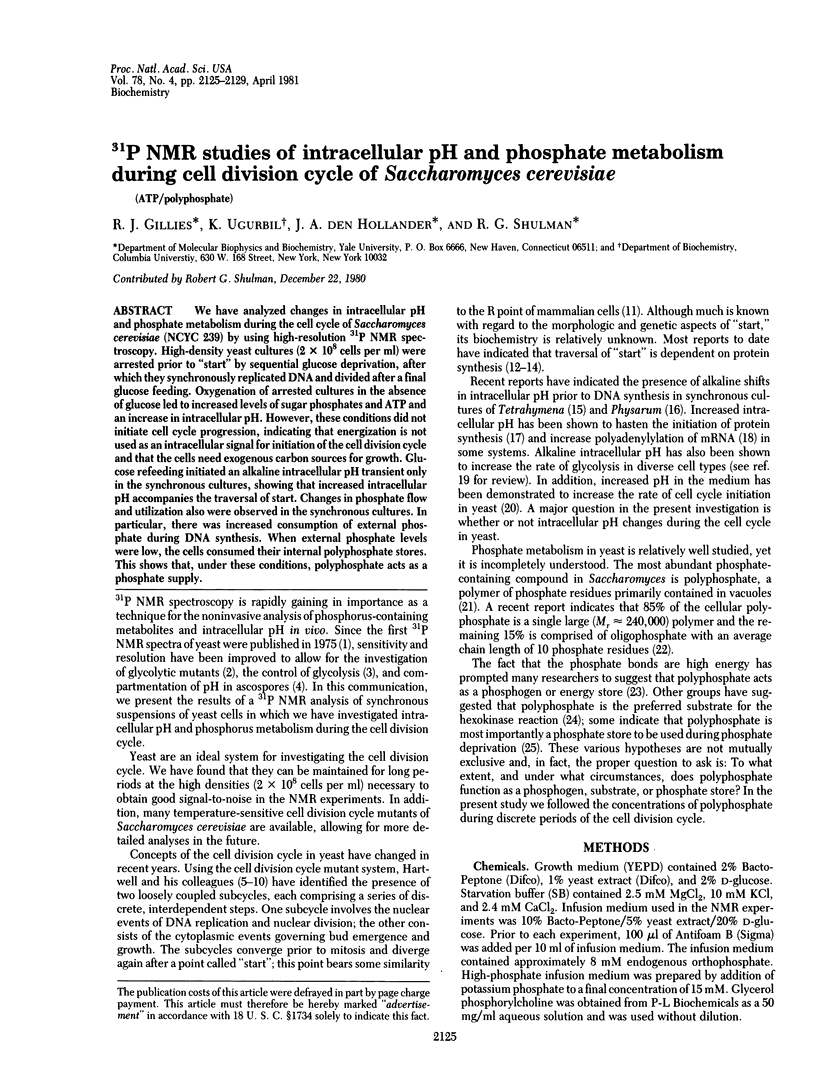
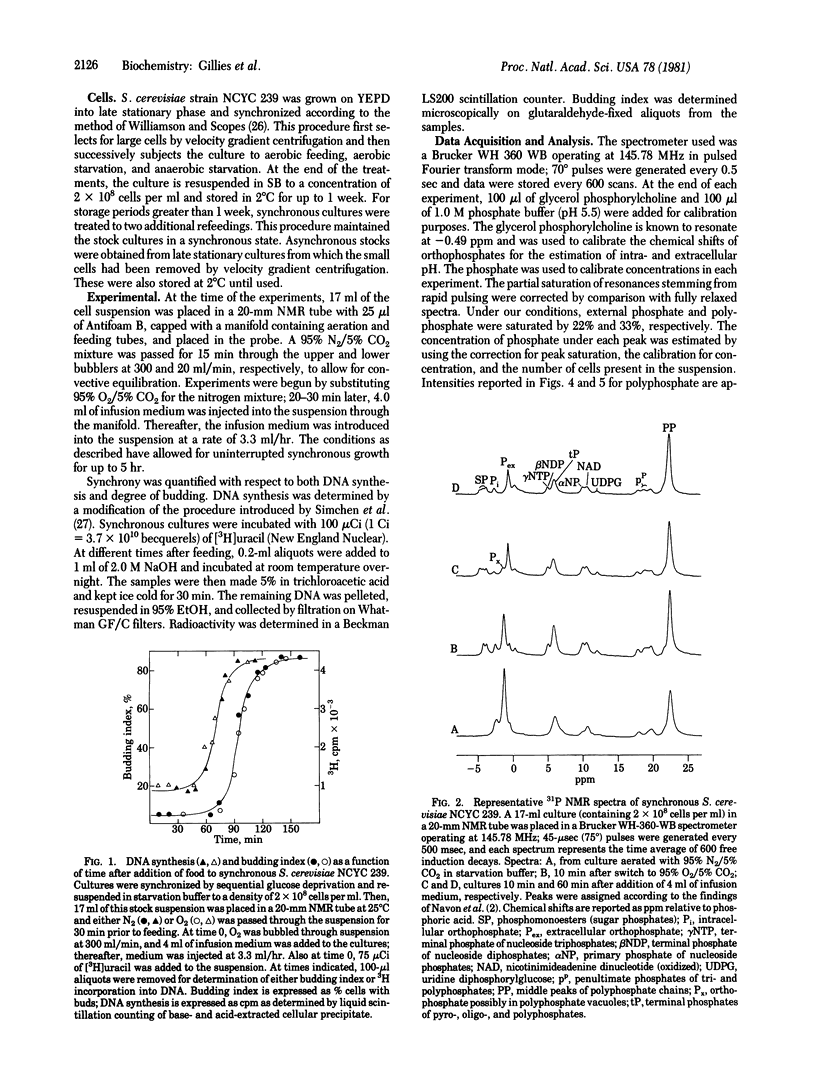
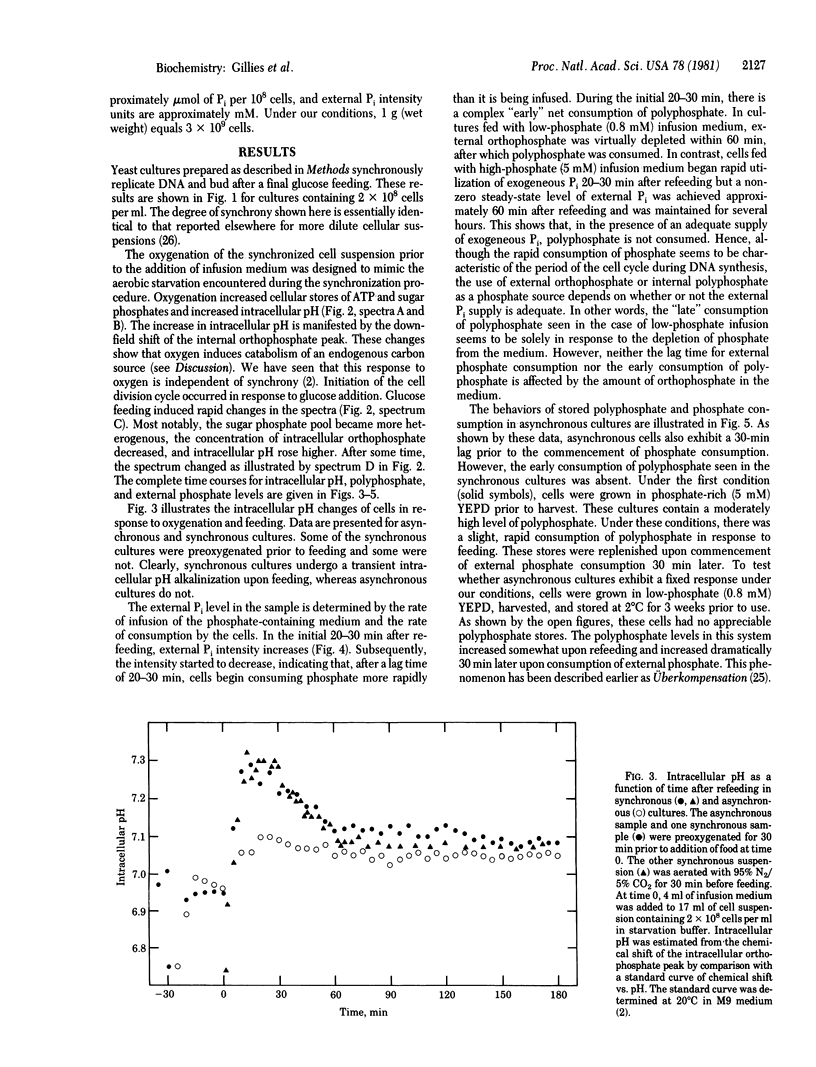
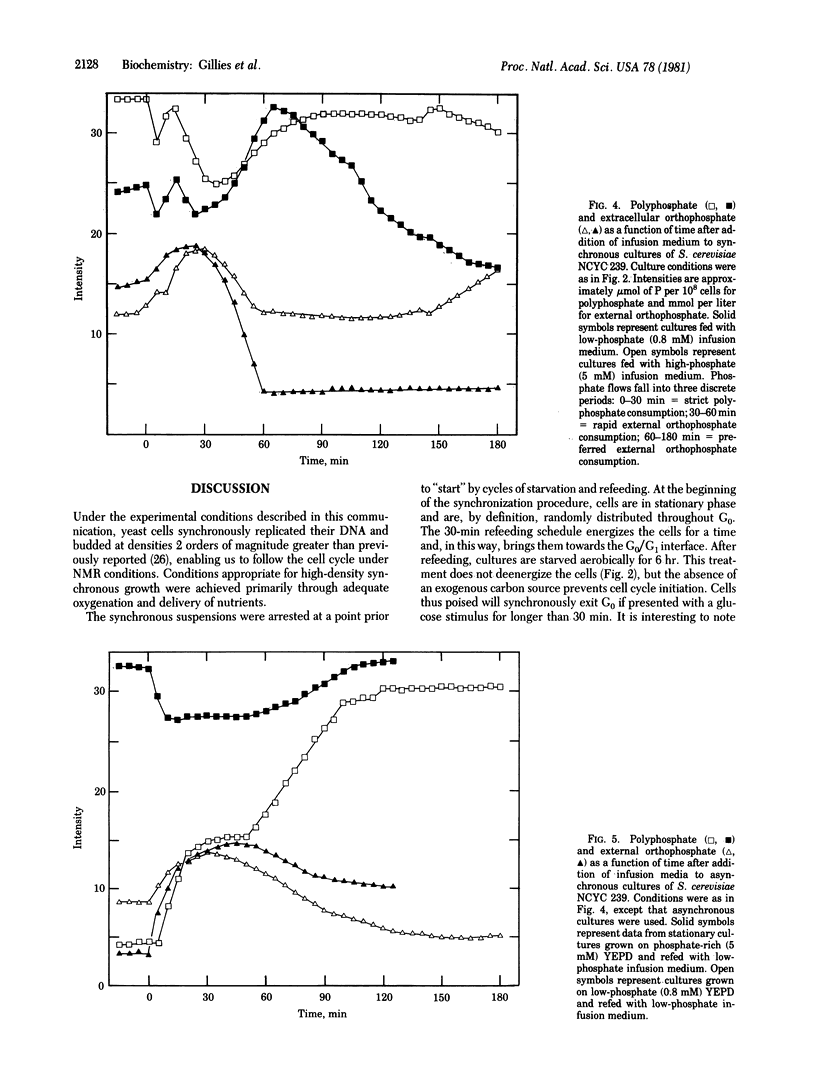
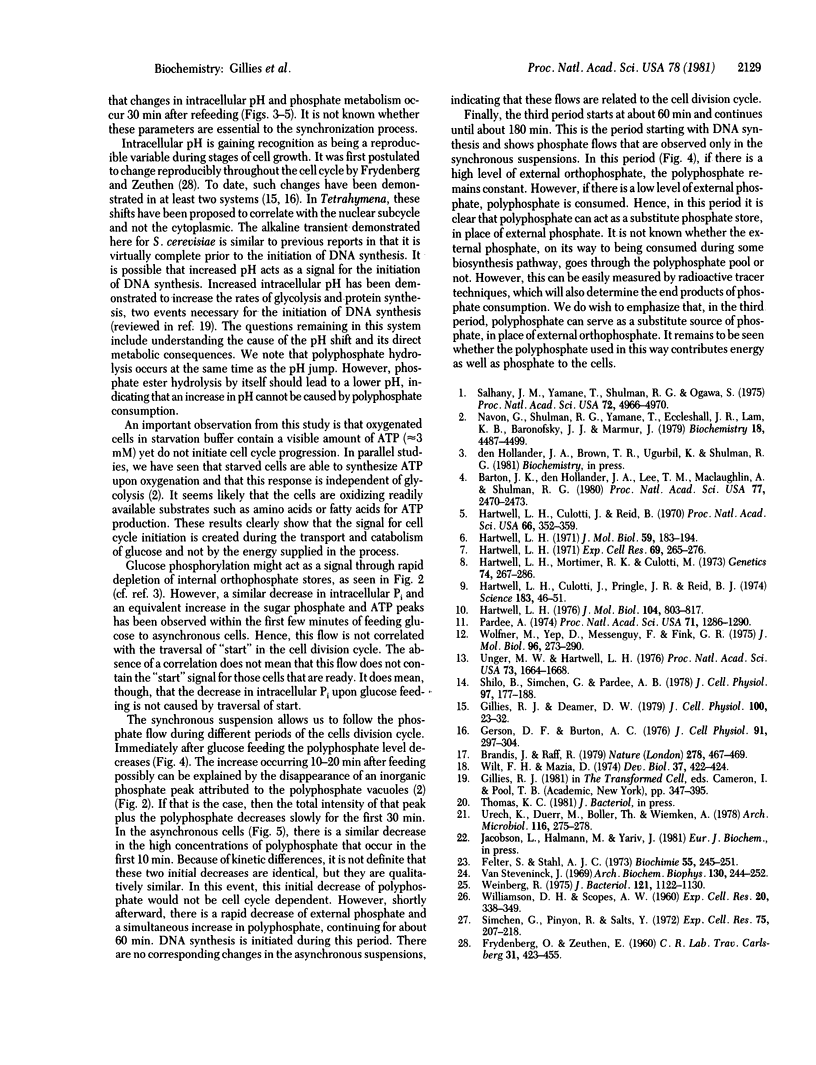
Selected References
These references are in PubMed. This may not be the complete list of references from this article.
- Barton J. K., den Hollander J. A., Lee T. M., MacLaughlin A., Shulman R. G. Measurement of the internal pH of yeast spores by 31P nuclear magnetic resonance. Proc Natl Acad Sci U S A. 1980 May;77(5):2470–2473. doi: 10.1073/pnas.77.5.2470. [DOI] [PMC free article] [PubMed] [Google Scholar]
- Brandis J. W., Raff R. A. Elevation of protein synthesis is a complex response to fertilisation. Nature. 1979 Mar 29;278(5703):467–469. doi: 10.1038/278467a0. [DOI] [PubMed] [Google Scholar]
- FRYDENBERG O., ZEUTHEN E. Oxygen uptake and carbon dioxide output related to the mitotic rhythm in the cleaving eggs of Dendraster excentricus and Urechis caupo. C R Trav Lab Carlsberg. 1960;31:423–455. [PubMed] [Google Scholar]
- Felter S., Stahl A. J. Enzymes du métabolisme des polyphosphates dans la levure. 3. Purification et propriétés de la polyphosphate-ADP-phosphotransferase. Biochimie. 1973;55(3):245–251. doi: 10.1016/s0300-9084(73)80122-1. [DOI] [PubMed] [Google Scholar]
- Gerson D. F., Burton A. C. The relation of cycling of intracellular pH to mitosis in the acellular slime mould Physarum polycephalum. J Cell Physiol. 1977 May;91(2):297–303. doi: 10.1002/jcp.1040910214. [DOI] [PubMed] [Google Scholar]
- Gillies R. J., Deamer D. W. Intracellular pH changes during the cell cycle in Tetrahymena. J Cell Physiol. 1979 Jul;100(1):23–31. doi: 10.1002/jcp.1041000103. [DOI] [PubMed] [Google Scholar]
- Hartwell L. H., Culotti J., Pringle J. R., Reid B. J. Genetic control of the cell division cycle in yeast. Science. 1974 Jan 11;183(4120):46–51. doi: 10.1126/science.183.4120.46. [DOI] [PubMed] [Google Scholar]
- Hartwell L. H., Culotti J., Reid B. Genetic control of the cell-division cycle in yeast. I. Detection of mutants. Proc Natl Acad Sci U S A. 1970 Jun;66(2):352–359. doi: 10.1073/pnas.66.2.352. [DOI] [PMC free article] [PubMed] [Google Scholar]
- Hartwell L. H. Genetic control of the cell division cycle in yeast. II. Genes controlling DNA replication and its initiation. J Mol Biol. 1971 Jul 14;59(1):183–194. doi: 10.1016/0022-2836(71)90420-7. [DOI] [PubMed] [Google Scholar]
- Hartwell L. H. Genetic control of the cell division cycle in yeast. IV. Genes controlling bud emergence and cytokinesis. Exp Cell Res. 1971 Dec;69(2):265–276. doi: 10.1016/0014-4827(71)90223-0. [DOI] [PubMed] [Google Scholar]
- Hartwell L. H., Mortimer R. K., Culotti J., Culotti M. Genetic Control of the Cell Division Cycle in Yeast: V. Genetic Analysis of cdc Mutants. Genetics. 1973 Jun;74(2):267–286. doi: 10.1093/genetics/74.2.267. [DOI] [PMC free article] [PubMed] [Google Scholar]
- Hartwell L. H. Sequential function of gene products relative to DNA synthesis in the yeast cell cycle. J Mol Biol. 1976 Jul 15;104(4):803–817. doi: 10.1016/0022-2836(76)90183-2. [DOI] [PubMed] [Google Scholar]
- Navon G., Shulman R. G., Yamane T., Eccleshall T. R., Lam K. B., Baronofsky J. J., Marmur J. Phosphorus-31 nuclear magnetic resonance studies of wild-type and glycolytic pathway mutants of Saccharomyces cerevisiae. Biochemistry. 1979 Oct 16;18(21):4487–4499. doi: 10.1021/bi00588a006. [DOI] [PubMed] [Google Scholar]
- Pardee A. B. A restriction point for control of normal animal cell proliferation. Proc Natl Acad Sci U S A. 1974 Apr;71(4):1286–1290. doi: 10.1073/pnas.71.4.1286. [DOI] [PMC free article] [PubMed] [Google Scholar]
- Salhany J. M., Yamane T., Shulman R. G., Ogawa S. High resolution 31P nuclear magnetic resonance studies of intact yeast cells. Proc Natl Acad Sci U S A. 1975 Dec;72(12):4966–4970. doi: 10.1073/pnas.72.12.4966. [DOI] [PMC free article] [PubMed] [Google Scholar]
- Shilo B., Simchen G., Pardee A. B. Regulation of cell-cycle initiation in yeast by nutrients and protein synthesis. J Cell Physiol. 1978 Nov;97(2):177–187. doi: 10.1002/jcp.1040970207. [DOI] [PubMed] [Google Scholar]
- Simchen G., Piñon R., Salts Y. Sporulation in Saccharomyces cerevisiae: premeiotic DNA synthesis, readiness and commitment. Exp Cell Res. 1972 Nov;75(1):207–218. doi: 10.1016/0014-4827(72)90538-1. [DOI] [PubMed] [Google Scholar]
- Unger M. W., Hartwell L. H. Control of cell division in Saccharomyces cerevisiae by methionyl-tRNA. Proc Natl Acad Sci U S A. 1976 May;73(5):1664–1668. doi: 10.1073/pnas.73.5.1664. [DOI] [PMC free article] [PubMed] [Google Scholar]
- Urech K., Dürr M., Boller T., Wiemken A., Schwencke J. Localization of polyphosphate in vacuoles of Saccharomyces cerevisiae. Arch Microbiol. 1978 Mar;116(3):275–278. doi: 10.1007/BF00417851. [DOI] [PubMed] [Google Scholar]
- WILLIAMSON D. H., SCOPES A. W. The behaviour of nucleic acids in synchronously dividing cultures of Saccharomyces cerevisiae. Exp Cell Res. 1960 Aug;20:338–349. doi: 10.1016/0014-4827(60)90162-2. [DOI] [PubMed] [Google Scholar]
- Weimberg R. Polyphosphate levels in nongrowing cells of Saccharomyces mellis as determined by magnesium ion and the phenomenon of "Uberkompensation". J Bacteriol. 1975 Mar;121(3):1122–1130. doi: 10.1128/jb.121.3.1122-1130.1975. [DOI] [PMC free article] [PubMed] [Google Scholar]
- Wilt F. H., Mazia D. The stimulation of cytoplasmic polyadenylylation in sea urchin eggs by ammonia. Dev Biol. 1974 Apr;37(2):422–424. doi: 10.1016/0012-1606(74)90158-4. [DOI] [PubMed] [Google Scholar]
- Wolfner M., Yep D., Messenguy F., Fink G. R. Integration of amino acid biosynthesis into the cell cycle of Saccharomyces cerevisiae. J Mol Biol. 1975 Aug 5;96(2):273–290. doi: 10.1016/0022-2836(75)90348-4. [DOI] [PubMed] [Google Scholar]
- van Steveninck J. The mechanism of transmembrane glucose transport in yeast: evidence for phosphorylation, associated with transport. Arch Biochem Biophys. 1969 Mar;130(1):244–252. doi: 10.1016/0003-9861(69)90030-7. [DOI] [PubMed] [Google Scholar]


